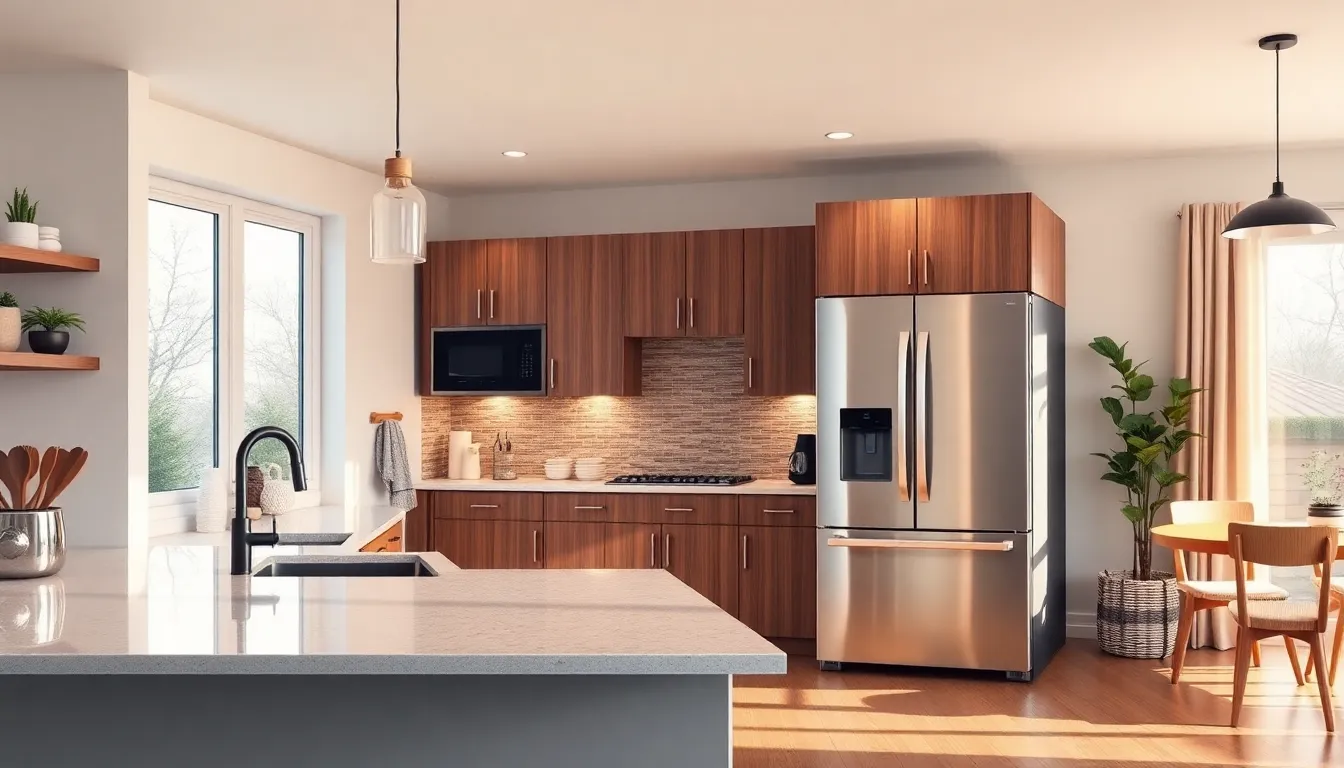Imagine walking into your home and having it greet you like an old friend. The lights dim to your favorite setting, your playlist starts playing, and the coffee machine brews that perfect cup—all without you lifting a finger. Welcome to the integrated home experience, where technology and comfort collide in a symphony of convenience.
In today’s fast-paced world, who wouldn’t want a home that anticipates their needs? From smart thermostats that learn your preferences to security systems that keep you safe while you binge-watch your favorite shows, this isn’t just luxury; it’s a lifestyle upgrade. So, buckle up as we explore how integrating your home’s technology can turn everyday living into an extraordinary adventure. After all, why just live in your home when you can thrive in it?
Table of Contents
ToggleOverview of Integrated Home Experience
Integrated home experience merges technology with daily living, creating a seamless environment tailored to individual needs. Home automation systems control lighting, heating, security, and entertainment, allowing users to manage their spaces effortlessly. Personalized settings enhance comfort; for instance, smart devices can adjust room temperatures when the homeowner arrives.
Smart appliances add convenience beyond basic functions. For example, a smart refrigerator can track inventory and suggest recipes based on available ingredients. This level of intelligence extends to other gadgets, such as speakers that recognize voice commands and deliver instant access to music or information.
Integration contributes to energy efficiency. Smart thermostats optimize heating and cooling, regulating energy consumption based on user habits. American households utilizing smart technology can save up to 30 percent on energy bills according to research from the U.S. Department of Energy.
Security features also improve with integration. Wireless security cameras and alarm systems offer real-time monitoring through smartphones, giving homeowners peace of mind. Users can receive alerts on potential issues and respond immediately, ensuring safety from anywhere.
Automation facilitates a customizable lifestyle. Homeowners can schedule various devices to operate automatically, aligning with their routines. Morning routines may start with lights turning on gradually, followed by coffee brewing and news playing softly.
Overall, the integrated home experience offers significant lifestyle enhancements. Different elements come together to create a cohesive living environment characterized by convenience, comfort, and security, transforming everyday activities into extraordinary experiences.
Benefits of Integrated Home Experience

An integrated home experience significantly elevates daily living through enhanced convenience and improved efficiency. Homeowners enjoy new levels of comfort that seamlessly blend technology into their routines.
Enhanced Convenience
Automated systems simplify everyday tasks. Smart appliances streamline meal preparation, with refrigerators suggesting recipes based on available ingredients. Lighting, heating, and entertainment can be controlled remotely, providing flexibility when managing home environments. Voice-activated assistants respond to commands, allowing for hands-free operation of devices. Homeowners can set customized schedules for routines, such as having coffee brewed and lights dimmed by the time they wake up. With integrated technology, even visitors feel welcomed with personalized settings adjusted for their preferences.
Improved Efficiency
Smart home systems foster energy conservation. For instance, smart thermostats optimize heating and cooling, leading to potential savings of up to 30 percent on energy bills. Homeowners benefit from real-time monitoring through energy usage reports, allowing them to make informed decisions. Efficient lighting systems adjust automatically based on natural light, reducing unnecessary power consumption. Home automation decreases resource waste, contributing to a more sustainable lifestyle. As functions integrate, daily operations become streamlined, leading to overall improved efficiency in managing household activities.
Key Components of Integrated Home Experience
Key components form the backbone of an integrated home experience. These elements come together, creating a smart, cohesive living environment.
Smart Appliances
Smart appliances revolutionize everyday tasks. Refrigerators can track inventory and display recipes, matching ingredients with user preferences. Additionally, ovens with remote control features allow users to preheat from anywhere. Laundry machines offer sensors that optimize wash cycles based on load size, ensuring efficient use of water and energy. Many smart appliances even send alerts when maintenance is due, promoting longevity and performance. Such convenience transforms mundane chores into effortless routines.
Home Automation Systems
Home automation systems centralize control for various home functions. Users can adjust lighting, temperature, and entertainment with a single interface or app. Scheduling allows homeowners to set routines, automatically dimming lights for movie nights or adjusting heating according to time of day. Energy-efficient settings can minimize consumption during peak hours. Compatibility with smart assistants enhances voice control, making daily interactions seamless. Overall, these systems create a harmonious living environment, tailored to individual lifestyles.
Connected Security Solutions
Connected security solutions enhance safety and peace of mind. Wireless cameras provide real-time surveillance and notifications to smartphones, ensuring homeowners remain informed about their surroundings. Doorbell cameras allow users to see and communicate with visitors remotely, strengthening home entry security. Smart locks enable secure access management, granting entry only to authorized individuals through apps. Alarm systems integrate with other devices for comprehensive monitoring, alerting homeowners to potential threats. Such advanced technology fosters a secure home environment for all residents.
Challenges in Implementing Integrated Home Experience
Implementing an integrated home experience presents several challenges. Factors such as technical barriers and cost considerations play significant roles in the adoption of smart home technology.
Technical Barriers
Technical barriers frequently hinder the implementation of integrated home experiences. Compatibility issues with existing devices often arise, restricting seamless connectivity. Many homeowners face difficulties integrating diverse brands and protocols, which can lead to frustration. Moreover, users may encounter challenges with system updates and software compatibility, affecting functionality. Limited technical expertise among users can further complicate setup and daily operations. Industry standards for smart home devices remain inconsistent, creating additional hurdles for effective integration.
Cost Considerations
Cost considerations significantly influence the feasibility of adopting integrated home experiences. Initial costs for smart appliances and automation systems can be prohibitively high. Homeowners must evaluate potential return on investment before making purchases. While energy savings can offset costs over time, upfront investments present financial strain for some households. Maintenance and repair expenses can add to the overall financial burden as well. Individuals often weigh long-term benefits against immediate expenditures, impacting their decision to embrace smart technology.
The integrated home experience represents a significant shift in how people interact with their living spaces. By merging technology with everyday routines, it creates a personalized environment that enhances comfort and efficiency. Homeowners can enjoy the convenience of automated systems that simplify daily tasks while promoting energy conservation and security.
Embracing this smart lifestyle can lead to transformative changes in how homes function. As technology continues to evolve, the possibilities for integration will expand, making it easier to create a cohesive living experience tailored to individual needs. While challenges exist, the long-term benefits of an integrated home make it a worthwhile consideration for those seeking to elevate their everyday lives.




